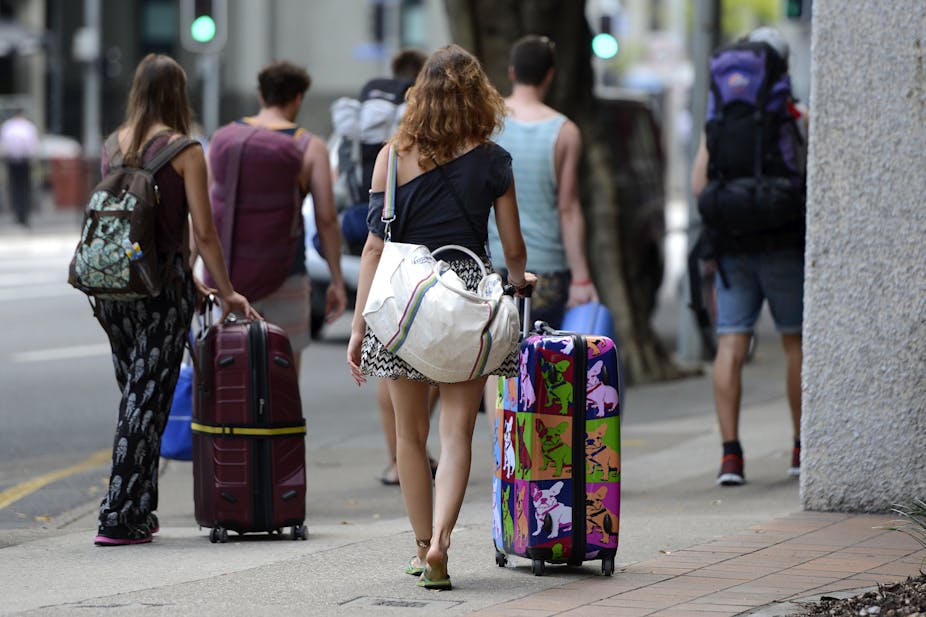While 457 temporary visas are currently under political scrutiny, thousands of other temporary migrants are now able to work in Australia for extended periods - most notably through working holiday visas and temporary graduate visas.
These visas primarily attract young people seeking an overseas work and life experience, or a pathway to more permanent migration.
Yet, because these visa categories are usually associated with international education and tourism, their significance as forms of labour migration are effectively hidden from public view and often underplayed by policy makers.
Unlike 457 workers, these workers don’t require employer sponsorship or specific skills, and participate in the labour market in diverse ways. Since 2006, the working holiday scheme has offered a second visa, extending stays from one to two years for migrants willing to spend three months doing regional work in specified industries such as agriculture, fishing and pearling, or mining and construction.
This has been a boon to regional employers, particularly those needing seasonal labour. Working holiday makers are picking grapes in our wine regions, or serving us in bars and cafes in our major cities. But they also participate in jobs beyond the typical “backpacker” stereotypes, in areas like IT, healthcare and skilled trades. There is also increasing evidence that women on working holiday visas are a source of foreign labour for the Australian sex industry.
With the global economic recovery still limiting employment options for young people in core source countries such as Ireland, working holidays are increasingly more about work than an extended tourist experience. At the end of 2012 there were 162,000 working holiday makers in Australia, with the number of arrivals increasing by nearly 60% from 2005-06 to 2009-10.
The 2011 Knight Reviewof the student visa system has also liberalised temporary post-study work options for international students. From early 2013, international students who have completed at minimum a Bachelors level qualification (involving at least two years study in Australia) are eligible for a two to four year post-study work visa, depending on their level of qualification. In 2012 there were over 216,000 international students in university courses in Australia.
If only one third of these take up the temporary graduate visa, this constitutes 72,000 new temporary migrants into the workforce. Employers can benefit from the temporary graduate scheme, gaining locally qualified workers, often with valuable multilingual skills and cultural capital. If these workers fill “in-demand” gaps on the Consolidated Sponsored Occupations List, they could also be sponsored and stay on at the end of their graduate visa period.
However, international graduates are not always considered “work ready” by industry, and Australian employers are often generally reluctant to hire workers with temporary visa statuses, particularly for professional positions. The new temporary graduate visas are primarily a means to maintain Australia’s education export market, as post-study work rights have become, globally, an important factor in international students’ choice of study destination.
What remains to be seen is whether Australian employers will give temporary graduates a go, or if too many graduates will end up underemployed and deskilled - reiterations of the old student-migrant trope of the taxi driver or convenience store worker with an Australian MBA.
Working holiday and temporary graduate schemes are important to the Australian economy and to Australian business. They shore up the international student market and the tourism industry. They allow important cultural and professional links to be forged between Australia and migrants’ home countries. And, they provide a workforce to fill specific skilled and unskilled labour market gaps.
However, these visa categories need to be properly acknowledged as important forms of labour migration, and the consequences of a long-term temporary workforce need to be carefully considered by both government and industry. “Visa churn” means temporary migrants can often remain in Australia on a series of temporary visas for far longer than their graduate or working holiday period allows. A migrant can arrive in Australia as an international student, complete an undergraduate and a Masters degree, and then work under a Temporary Graduate 485 visa for three years.
Similarly, a migrant could begin on a working holiday visa for two years, gain sponsorship and work on a 457 visa for four years, and then commence postgraduate study on a student visa. With casual work rights available to student visa holders, both pathways encompass at least eight to nine years of work and residency in Australia with a temporary status. Generally, the longer people stay, the longer they want to stay, yet these pathways do not guarantee permanent residency.
Socially and politically, legal classifications of “temporary” are problematic when migrants have many years of labour market participation, residency and paid taxes behind them. Moreover, Australia will have long-term members of society without access to many government-funded social services and welfare benefits, as well as potential for worker exploitation, and for the integration of temporary workers into grey labour economies.
For these schemes to be successful for both employers and migrants, we need acknowledgement that temporary graduates and working holiday makers are important sources of migrant labour, and ensure their skills are properly utilised, and their rights adequately protected.

